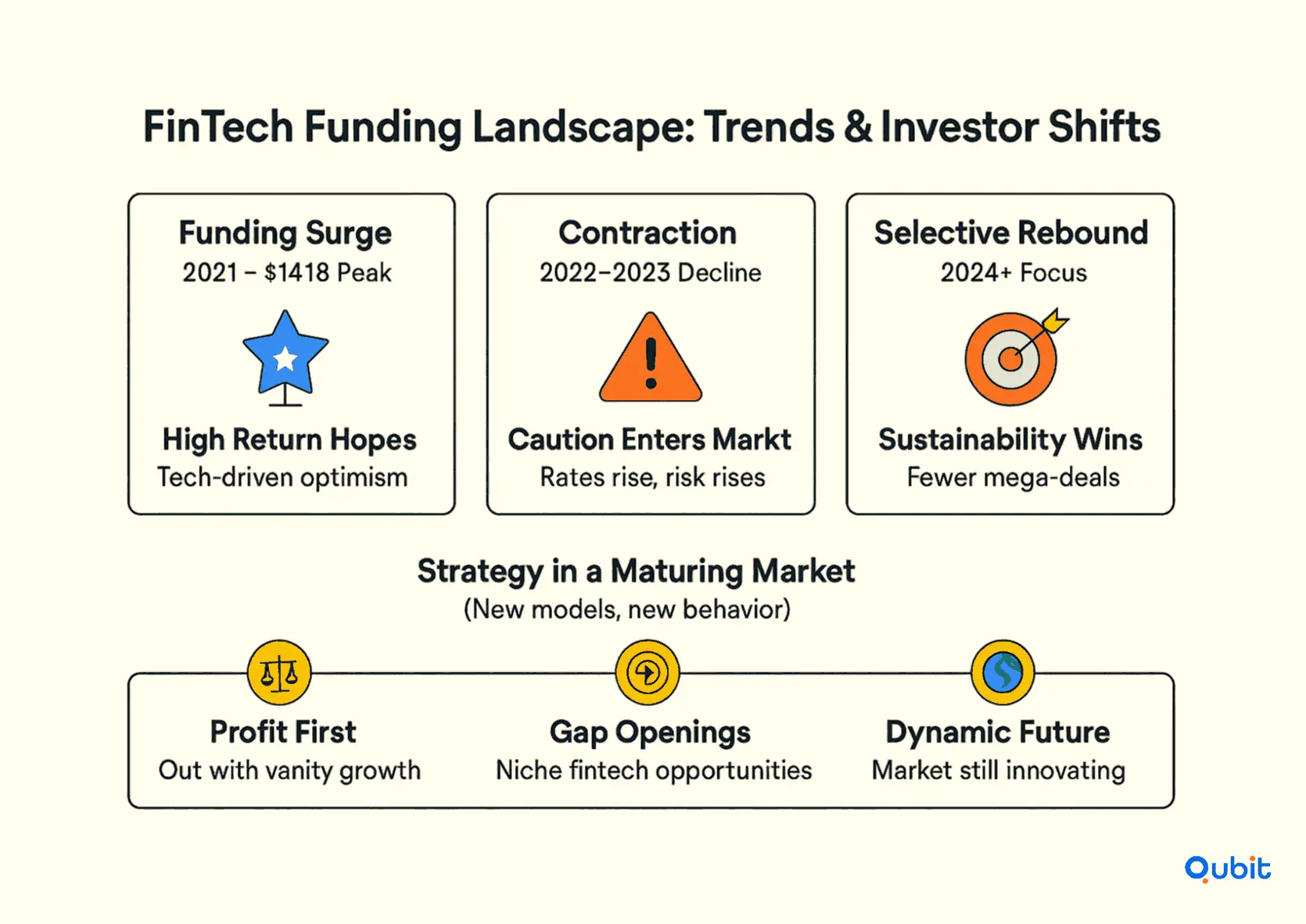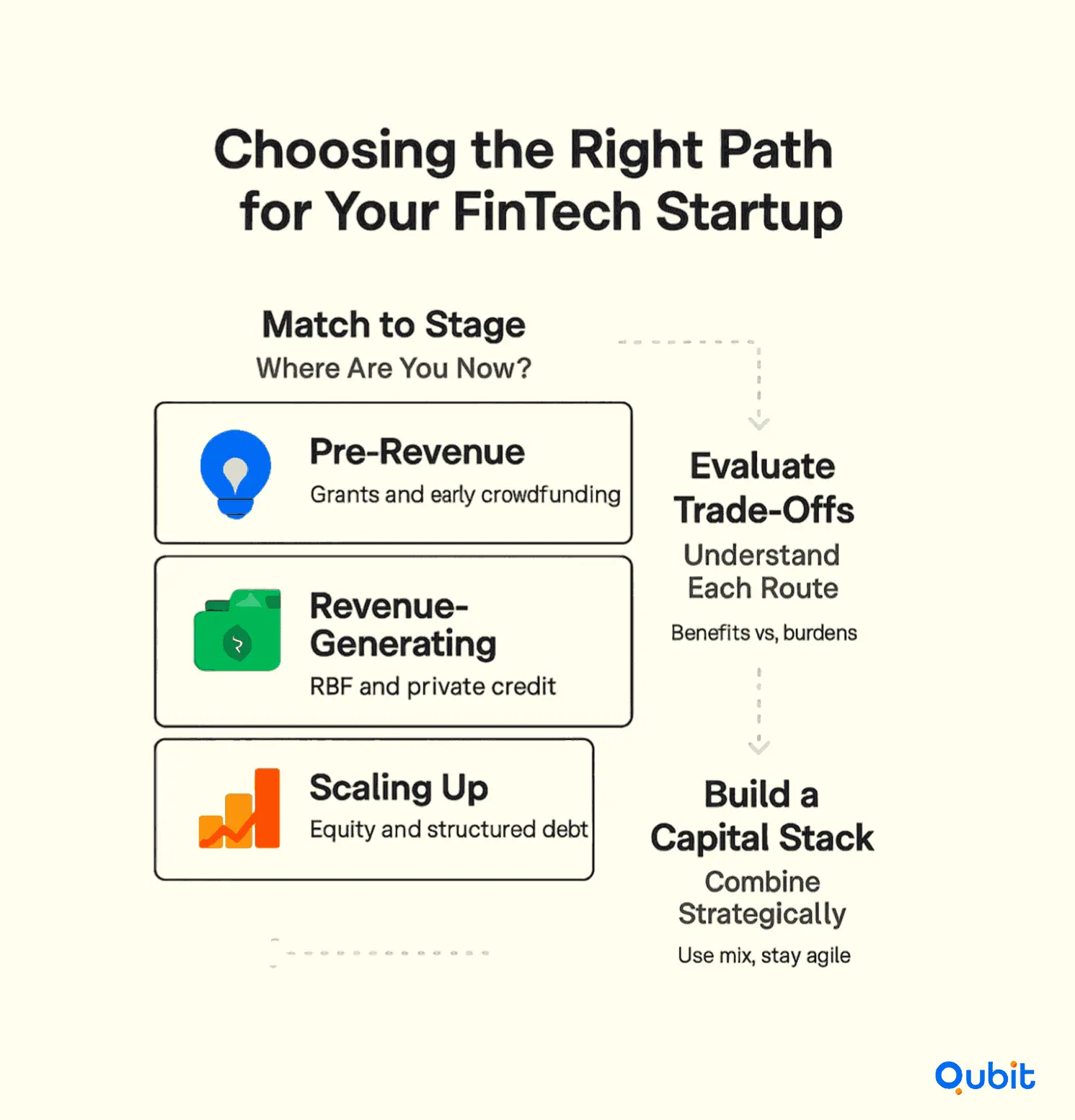Fintech funding is no longer an open tap. In 2024, annual fintech deals fell by 17% to 3,580 transactions, while total funding dropped 20% to $33.7 billion (Crunchbase 2024). Globally, investment across venture capital, private equity, and M&A slid to a seven-year low of $95.6 billion over 4,639 deals (Statista 2024). As an early-stage fintech founder, you need to look beyond traditional venture rounds.
Your exploration of alternative funding strategies is well complemented by the comprehensive overview in fintech fundraising strategies and opportunities, which situates various financing methods within a broader market context.
This article maps out six strategic funding paths, revenue based financing, private credit, private equity, crowdfunding, tokenization, and grants, and shows you how to match each to your growth stage and goals.
Understanding the Fintech Funding Landscape: Trends and Challenges

The fintech sector has experienced a dramatic shift in funding patterns over the past few years, reflecting broader economic and market dynamics. From a record-breaking $141 billion in 2021, global fintech funding plummeted to $75 billion in 2022 and further dropped to $39 billion in 2023. This sharp decline underscores the challenges posed by rising interest rates, macroeconomic uncertainties, and evolving investor behaviors.
The Rise and Fall of Fintech Funding
In 2021, fintech funding reached unprecedented levels, with investments totaling $141 billion. This surge was fueled by optimism surrounding digital transformation, the rapid adoption of financial technologies, and the promise of high returns. However, the following year marked a significant reduction, with funding falling to $75 billion—a clear indication of shifting investor sentiment. By 2023, cautious behavior among investors and a maturing market environment contributed to a further decline, bringing the total down to $39 billion.
The downturn reflects a combination of factors. Rising interest rates have made capital more expensive, discouraging large-scale investments. Additionally, macroeconomic uncertainties—such as inflation and geopolitical tensions—have prompted investors to reassess risk. As the market matures, the once-explosive growth of fintech has slowed, leading to more selective funding decisions.
Investor Behavior in a Maturing Market
Investor caution has become a defining feature of the current fintech funding landscape. Unlike the exuberance of previous years, today’s investors are prioritizing profitability and sustainability over rapid expansion. This shift is evident in the reduced number of mega-rounds and a growing focus on smaller, strategic investments.
Despite the challenges, the evolving market presents opportunities for new entrants. Emerging fintech startups can capitalize on gaps left by established players, particularly in niche areas such as alternative financing. According to Forbes research, the fintech sector remains dynamic, with innovative solutions continuing to attract attention.
Alternative Funding Strategies in Fintech Sector
As traditional funding sources become less accessible, alternative solutions are gaining traction. Let's take a look at them:
Revenue Based Financing for Fintech Startups
What It Is
Revenue based financing (RBF) blends debt and equity. You receive a lump sum upfront in exchange for a fixed percentage of future revenues. Unlike traditional loans, repayments scale with your sales and unlike equity deals, you don’t surrender ownership.
How It Works
- Advance: You secure capital based on projected sales.
- Repayments: You remit a share of your revenue (often 2–8%) until a cap (commonly 1.2× to 1.5× the advance) is met.
- Term: The payback period typically spans 3–5 years, but extends if revenues dip.
Why It Fits Fintech
Short-term revenue swings can strain your cash flow. RBF smooths peaks and valleys without fixed interest or dilution. It rewards companies with recurring revenue, such as subscription-based payment platforms or lending services.
The global RBF market was valued at $7.3 billion in 2024 and is projected to reach $528 billion by 2033 at a 60.9% CAGR. In India, GetVantage financed roughly 750 firms in FY 24, helping them scale without giving up equity. Government schemes like India’s Fund of Funds for Startups maintain a ₹10,000 crore corpus for non-dilutive support.
Private Credit Options
Institutional Debt Funds
Large private credit funds now team with banks to back fintech lenders. Carlyle and Citigroup launched an asset-backed financing partnership to support loan books and receivables, tapping Citi’s $25 billion Apollo program (Carlyle & Citigroup 2024).
Asset-Backed Structures
If you run a lending platform, you can securitize your loan portfolio. Affirm secured a $4 billion commitment from Sixth Street to enable up to $20 billion in new consumer loans over three years. Sixth Street now manages over $80 billion in assets, giving you a reliable source of flexible capital (Sixth Street 2024).
Private Equity Partnerships for Fintech Startups
Role of PE Firms
Private equity (PE) brings more than money. These firms add operational expertise, governance discipline, and global networks. They often drive strategy, compliance, and scaling to accelerate your path to profitability.
What PE Firms Look For
- Product-Market Fit: Demonstrable traction and adoption.
- Unit Economics: Healthy margins and sustainable acquisition costs.
- Profitability Path: A clear roadmap to break-even and positive cash flow.
Canoe Intelligence closed a Series A extension led by Blackstone Innovations and Carlyle, highlighting how leading PE firms back fintechs that optimize financial workflows. KKR invested $500 million in JD Digits to scale its AI-driven banking services for SMEs . In the Philippines, KKR’s stake in Maya saw ₱39 billion in deposits and ₱68 billion in disbursements by end-2024, underscoring PE’s role in rapid growth.
Crowdfunding and Tokenization
Crowdfunding for Fintech Startups
Equity and reward-based crowdfunding tap a broad community without ceding control to one investor. On Seedrs, 266 companies raised £353 million in 2023, with an 88% campaign success rate (Seedrs 2023). Crowdfunding works best when your product resonates directly with end users.
Tokenization Models
- Security Tokens: Blockchain-based equity or debt.
- Utility Tokens: Access to services or platform features.
Tokenization can attract crypto-native investors and increase liquidity. It demands robust legal and technical frameworks to stay compliant. The global crowdfunding market reached $24.05 billion in 2024 and is set to grow to $108.64 billion by 2033 (Statista 2024).
Grants and Government Programs
Non-Dilutive Funding Sources
Grants bridge your early-stage runway without equity or debt. In the U.S., the Small Business Administration’s PRIME program awarded $7 million to micro-entrepreneur support organizations in 2024 (U.S. SBA 2024). The Growth Accelerator Fund Competition granted over $3 million across 44 accelerator partnerships, each receiving $50–$150 thousand for STEM and R&D startups.
Globally, India’s Startup India initiative offers grants, tax relief, and credit guarantees via SIDBI and other bodies. Explore local innovation grants and fintech accelerators for non-dilutive options (SIDBI 2024).
Application Tips
- Align Stages: Match your phase—idea, prototype, or revenue—to program criteria.
- Keep Proposals Concise: Highlight problem, solution, market size, traction, and team in under five pages.
- Show Impact: Emphasize job creation, financial inclusion, or technological innovation.
Choosing the Right Path for Your Fintech Startup

Match to Your Stage
- Pre-Revenue: Grants and early crowdfunding validate concepts.
- Revenue-Generating: Revenue based financing and private credit fund growth without heavy dilution.
- Scaling: Private equity and large debt facilities power expansion and diversification.
Weighing Trade-Offs
Every funding source has trade-offs. Equity brings strategic partners but dilutes ownership. Debt preserves equity but adds fixed obligations. Crowdfunding builds a community but demands marketing effort. Grants are free but highly competitive.
Building a Blended Capital Stack
Combine multiple sources to extend your runway and reduce dependency on any single investor. Use grants for R&D, RBF for working capital, private credit for loan book growth, and a small equity round for strategic guidance. Cultivate relationships early with grant officers, private credit specialists, and PE scouts. Develop clear financial models and data-driven traction metrics. In negotiations, choose partners who share your vision and contribute more than just capital.
Conclusion
Alternative funding is a toolbox, not a fallback. By weaving together revenue based financing, private credit, private equity, crowdfunding, tokenization, and grants, you build resilience into your capital strategy. Each source fits a specific stage of your journey. Align funding to your needs, maintain flexibility, and manage cost of capital. As an early-stage fintech founder, you have the creativity to craft a tailored roadmap. Seek partners who add value beyond dollars. With a blended and strategic approach, you can secure the resources to bring your fintech vision to life.
If you're ready to explore alternative funding strategies, contact us at Qubit Capital for our Fundraising Assistance services to secure the best financial pathway for your startup.
Key Takeaways
- Fintech funding has significantly declined, highlighting a maturing market.
- Alternative funding strategies offer diverse avenues, each with distinct advantages and challenges.
- Data-driven insights and real-world case studies provide actionable strategies for fintech funding.
Frequently asked Questions
What are alternative funding options for fintech startups?
Fintech startups can explore various funding avenues, including venture capital, angel investors, revenue-based financing, crowdfunding, merchant cash advances, customer pre-payments, incubators, accelerators, and pitch competitions. Each option offers distinct advantages and challenges tailored to the needs of fintech businesses.


 Back
Back



